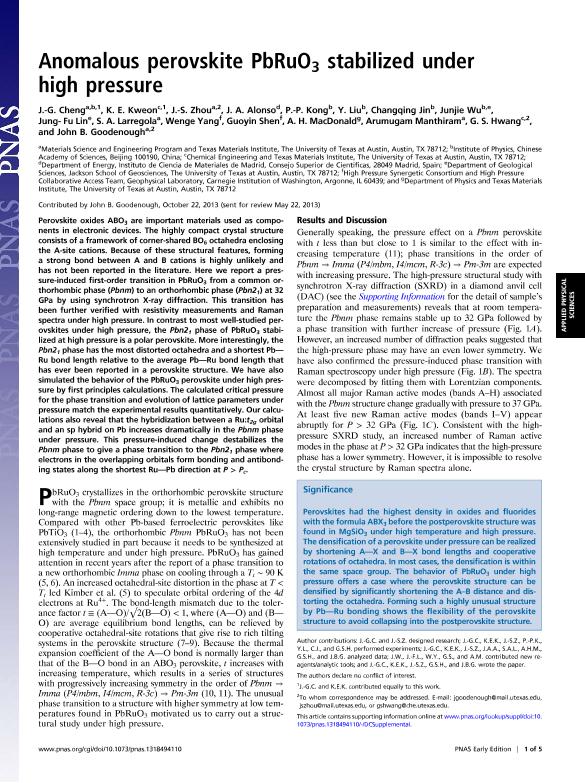Mostrar el registro sencillo del ítem
dc.contributor.author
Cheng, J. G.
dc.contributor.author
Kweon, K. E.
dc.contributor.author
Zhou, J. S.
dc.contributor.author
Alonso, J. A.
dc.contributor.author
Kong, P. P.
dc.contributor.author
Liu, Y.
dc.contributor.author
Jin,Changqing
dc.contributor.author
Wu, Junjie
dc.contributor.author
Lin, Jung Fu
dc.contributor.author
Larregola, Sebastian Alberto

dc.contributor.author
Yang, Wenge
dc.contributor.author
Shen, Guoyin
dc.contributor.author
MacDonald, A. H.
dc.contributor.author
Manthiram, Arumugam
dc.contributor.author
Hwang, G. S.
dc.contributor.author
Goodenough, John B.
dc.date.available
2017-11-28T16:49:32Z
dc.date.issued
2013-10
dc.identifier.citation
Cheng, J. G.; Kweon, K. E.; Zhou, J. S. ; Alonso, J. A.; Kong, P. P. ; et al.; Anomalous perovskite PbRuO3 stabilized under high pressure; National Academy of Sciences; Proceedings of the National Academy of Sciences of The United States of America; 110; 50; 10-2013; 20003-20007
dc.identifier.issn
0027-8424
dc.identifier.uri
http://hdl.handle.net/11336/29214
dc.description.abstract
Perovskite oxides ABO3 are important materials used as components in electronic devices. The highly compact crystal structure consists of a framework of corner-shared BO6 octahedra enclosing the A-site cations. Because of these structural features, forming a strong bond between A and B cations is highly unlikely and has not been reported in the literature. Here we report a pressure-induced first-order transition in PbRuO3 from a common orthorhombic phase (Pbnm) to an orthorhombic phase (Pbn21) at 32 GPa by using synchrotron X-ray diffraction. This transition has been further verified with resistivity measurements and Raman spectra under high pressure. In contrast to most well-studied perovskites under high pressure, the Pbn21 phase of PbRuO3 stabilized at high pressure is a polar perovskite. More interestingly, the Pbn21 phase has the most distorted octahedra and a shortest Pb—Ru bond length relative to the average Pb—Ru bond length that has ever been reported in a perovskite structure. We have also simulated the behavior of the PbRuO3 perovskite under high pressure by first principles calculations. The calculated critical pressure for the phase transition and evolution of lattice parameters under pressure match the experimental results quantitatively. Our calculations also reveal that the hybridization between a Ru:t2g orbital and an sp hybrid on Pb increases dramatically in the Pbnm phase under pressure. This pressure-induced change destabilizes the Pbnm phase to give a phase transition to the Pbn21 phase where electrons in the overlapping orbitals form bonding and antibonding states along the shortest Ru—Pb direction at P > Pc.
dc.format
application/pdf
dc.language.iso
eng
dc.publisher
National Academy of Sciences

dc.rights
info:eu-repo/semantics/openAccess
dc.rights.uri
https://creativecommons.org/licenses/by-nc/2.5/ar/
dc.subject
Perovskite
dc.subject
High Pressure
dc.subject
Intermetallic
dc.subject
Ruthenate
dc.subject.classification
Astronomía

dc.subject.classification
Ciencias Físicas

dc.subject.classification
CIENCIAS NATURALES Y EXACTAS

dc.title
Anomalous perovskite PbRuO3 stabilized under high pressure
dc.type
info:eu-repo/semantics/article
dc.type
info:ar-repo/semantics/artículo
dc.type
info:eu-repo/semantics/publishedVersion
dc.date.updated
2017-10-17T14:36:05Z
dc.journal.volume
110
dc.journal.number
50
dc.journal.pagination
20003-20007
dc.journal.pais
Estados Unidos

dc.journal.ciudad
Washington, DC
dc.description.fil
Fil: Cheng, J. G.. University of Texas at Austin; Estados Unidos. Chinese Academy of Sciences; República de China
dc.description.fil
Fil: Kweon, K. E.. University of Texas at Austin; Estados Unidos
dc.description.fil
Fil: Zhou, J. S.. University of Texas at Austin; Estados Unidos
dc.description.fil
Fil: Alonso, J. A.. Instituto de Ciencia de Materiales de Madrid; España
dc.description.fil
Fil: Kong, P. P.. Chinese Academy of Sciences; República de China
dc.description.fil
Fil: Liu, Y.. Chinese Academy of Sciences; República de China
dc.description.fil
Fil: Jin,Changqing. Chinese Academy of Sciences; República de China
dc.description.fil
Fil: Wu, Junjie. Chinese Academy of Sciences; República de China. University of Texas at Austin; Estados Unidos
dc.description.fil
Fil: Lin, Jung Fu. University of Texas at Austin; Estados Unidos
dc.description.fil
Fil: Larregola, Sebastian Alberto. University of Texas at Austin; Estados Unidos. Consejo Nacional de Investigaciones Científicas y Técnicas. Centro Científico Tecnológico Conicet - San Luis. Instituto de Investigaciones en Tecnología Química. Universidad Nacional de San Luis. Facultad de Química, Bioquímica y Farmacia. Instituto de Investigaciones en Tecnología Química; Argentina
dc.description.fil
Fil: Yang, Wenge. Carnegie Institution of Washington; Estados Unidos
dc.description.fil
Fil: Shen, Guoyin. Carnegie Institution of Washington; Estados Unidos
dc.description.fil
Fil: MacDonald, A. H.. University of Texas at Austin; Estados Unidos
dc.description.fil
Fil: Manthiram, Arumugam. University of Texas at Austin; Estados Unidos
dc.description.fil
Fil: Hwang, G. S.. University of Texas at Austin; Estados Unidos
dc.description.fil
Fil: Goodenough, John B.. University of Texas at Austin; Estados Unidos
dc.journal.title
Proceedings of the National Academy of Sciences of The United States of America

dc.relation.alternativeid
info:eu-repo/semantics/altIdentifier/url/http://www.pnas.org/content/110/50/20003
dc.relation.alternativeid
info:eu-repo/semantics/altIdentifier/doi/http://dx.doi.org/10.1073/pnas.1318494110
dc.relation.alternativeid
info:eu-repo/semantics/altIdentifier/url/https://www.ncbi.nlm.nih.gov/pmc/articles/PMC3864321/
Archivos asociados
